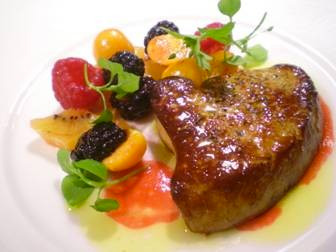

July 1st marks the official start of the state-wide ban.
The story begins about eight years ago, during the tenure of Arnold Schwarzenegger. Whether the Governator ever succumbed to the sweet, buttery decadence of foie gras au torchon in a fit of indulgence, I can’t say. Though, given his affinity for lean muscle, I have my doubts. Regardless, he signed the bill introduced by Senator John Burton and backed by four animal rights groups, allowing a grace period for California’s sole producer of the delicacy, Sonoma Foie Gras, to come up with an objectively humane way to carry out the centuries-old tradition of gavage. Now, time is up.
For a while, chefs and restaurateurs were up in arms over their loss. Anyone in attendance at the many James Beard-related events surrounding this year’s awards ceremony would have noticed the “Save the Foie” pins that were the accessory du jour. Then there was a petition that won the names of over 100 chefs in the fine dining sector and a coalition that proposed an alternate solution, the Humane and Ethical Foie Gras Act, with new regulations like hand-feeding and cage-free environments. But at this late stage, most of the chefs I’ve spoken to seem resigned to let the ban take effect. “I would rather let it go to bed quietly without any fuss,” says Chef Jason Berthold of San Francisco’s RN74, with an aside: “… and hope that this will only be a temporary phase.”
Several restaurants have taken this opportunity to give their guests one last hurrah. The Fifth Floor has featured a five-course foie gras tasting menu at $120 for the month of June. “We’re wrapping it up right,” says sommelier Amy Goldberger. “The last week will be crazy here. I just hope we have enough wine to get through it!” From foie gras béarnaise-topped oysters to fried rhubarb pie with foie gras ice cream, she’s having a blast with the pairings. “Even our lacquered foie gras dish, which is so rich and intense, you can do a red Burgundy or a sweet wine or even Sherry.” Goldberger reports that her guests have been upset by the news of the ban, and a protest outside the hotel actually resulted in a reservations boom. “Several tables said they wouldn’t have known about the special menu without seeing the protesters, and they all did the full foie menu and the wine pairing,” she says.
Chef Hiro Sone has dreamed up a foie gras ramen over at Ame in San Francisco, and sommelier John Vuong says, “They’re gobbling it up.” With it, Vuong is pairing a namazake genshu sake: Minato “Harbor” Tsuchizaki Yamahai. “It’s coming out very fresh and very viscous,” he notes.
But what he’ll miss most without foie gras in his arsenal is the chance to turn people on to sweet wines, particularly Sauternes, off-dry German riesling and chenin blanc. “The richness of foie, how the fat envelops your tongue, it calls for a wine with a little perceived sugar,” he says. “And normally, people are turned off by sweetness in wine for whatever reason.”
Chef Berthold is more worried about how the ban will affect fledgling culinary professionals. “Being able to teach the next generation of chefs how to handle and prepare foie gras is something that many chefs will miss,” he says. “It’s unfortunate that a culinary student at CIA Greystone in St. Helena would not be able to learn the ways of working with such an historical ingredient, while the same student would be able to if they were attending the CIA in Hyde Park.” In an effort to keep the teaching process alive, he’s been filming videos on cleaning foie for terrine, portioning for sautéing and how to cook and present a whole lobe, all the while planning some special last dishes for his guests to enjoy.
In Los Angeles, Chef Sang Yoon (Father’s Office and Lukshon) is questioning the ban’s effectiveness. “Chefs are pissed, but I don’t think the average person walking down the street even knows,” he says. “It’s a fringe ingredient. The spirit of the law is good, but they’re applying it to something trivial and meaningless in terms of its scale. We’re talking about fine dining restaurants, and even then maybe one dish on the menu… I don’t know why they don’t go after eggs. Industrial egg farming is gross.”
This is a W&S web exclusive feature.
This is a W&S web exclusive. Get access to all of our feature stories by signing up today.















